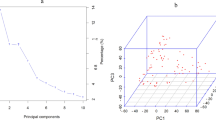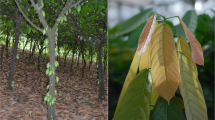Summary
In a twin study, we have shown that wild emmer wheat, Triticum dicoccoides, the progenitor of all cultivated wheats, harbours important genetic variation (Vg) in photosynthetic characteristics. This Vg resides within and between populations and ecogeographical regions in Israel, which is the center of origin and diversity of wild emmer wheat. Here we analyzed, by univariate and multivariate methods, the significant differentiation of variation in photosynthetic characteristics of 107 genotypes from 27 populations of wild emmer in Israel, distributed in three ecogeographical regions including central, xeric (northern cold and eastern warm) marginal, and mesic (western) marginal populations. The highest photosynthetic efficiency was displayed by populations of the xeric marginal region, but most variation for photosynthetic capacity occurs between accessions within ecogeographical regions and populations. Genotypes and populations of T. dicoccoides having high photosynthetic capacity can be identified by climatic factors and isozyme markers. The identification by genetic markers, if substantiated by testcrosses, can facilitate the maximization of conservation, in situ or ex situ, and utilization of these photosynthetic genetic resources for improvement of hexaploid wheat (T. aestivum).
Similar content being viewed by others
References
Avery D (1985) Farm dilemma: the global bad news in wrong. Science 230:408–412
Avivi L (1978) High grain protein content in wild tetraploid wheat, Triticum dicoccoides Korn. In: Ramanujam S (ed) Proc 5th Int Wheat Genet Symp. Indian Society of Genetics and Plant Breeding, New Delhi, pp 372–380
Brown AHD, Clegg MT (1983) Isozyme assessment of plant genetic resources. In: Rattazzi MC, Scandalios GJ, Whitt AR (eds) Isozymes: current topics in biological and medical research, vol 11, medical and other applications. Alan R Liss, New York, pp 285–295
Carver BF, Nevo E (1990) Genetic diversity of photosynthetic characters in native populations of Triticum dicoccoides. Photosynth Res 25: 119–128
Carver BF, Johnson RC, Rayburn AL (1989) Genetic analysis of photosynthetic variation in hexaploid and tetraploid wheat and their interspecific hybrids. Photosynth Res 20: 105–118
Cressey PJ, Macgibbon DG, Grama A (1987) Hexaploid wild emmer wheat derivatives grown under New Zealand conditions. 3. Influence of nitrogen fertilization and stage of grain development on protein composition. NZ J Agric Res 30:53–58
Feldman M (1979) Genetic resources of wild wheats and their use in breeding. Monogr Genet Agrar 4: 9–26
Feldman M, Sears ER (1981) The wild gene resources of wheat. Sci Am 244: 102–112
Frankel OH, Bennett E (1970) Genetic resources in plants —their exploration and conservation. Blackwell, Oxford
Frankel OH, Hawkes JG (eds) (1975) Crop genetic resources for today and tomorrow. Int Biol Prog 2, Cambridge University Press, Cambridge
Frankel OH, Soulé ME (1980) Conservation and evolution. Cambridge University Press, Cambridge
Gerechter-Amitai ZK, Grama A (1974) Inheritance of resistance to stripe rust (Puccinia striiformis) in crosses between wild emmer (Triticum dicoccoides) and cultivated tetraploid and hexaploid wheats. I. Triticum durum. Euphytica 23:387–392
Gerechter-Amitai ZK, Grama A (1977) Use of alien genes in wheat breeding. Annu Wheat Newsl 23:57–58
Gerechter-Amitai ZK, Silfhout CH van (1989) Race-specificity of temperature-sensitive genes for resistance to Puccinia striiformis in Triticum dicoccoides. Euphytica 43:7–14
Gerechter-Amitai ZK, Stubbs RW (1970) A valuable source of yellow rust resistance of Israeli population of wild emmer, Triticum dicoccoides. Euphytica 19: 12–21
Gerechter-Amitai ZK, Grama CH, Silfhout CH van, Kleitman F (1989a) Resistance to yellow rust in Triticum dicoccoides. II. Crosses with resistant Triticum dicoccoides sel. G-25. Neth J Plant Pathol 95: 79–83
Gerechter-Amitai ZK, van Silfhout CH, Grama A, Kleitman F (1989b) Yr15 —a new gene for resistance to Puccinia striiformis in Triticum dicoccoides sel. G-25. Euphytica 43: 187
Grama A, Gerechter-Amitai ZK (1974) Inheritance of resistance to stripe rust (Puccinia striiformis) in crosses between wild emmer (Triticum dicoccoides) and cultivated tetraploid and hexaploid wheats. II. Triticum aestivum. Euphytica 23: 393–398
Grama A, Gerechter-Amitai ZK, Blum A (1983) Wild emmer as donor of genes for resistance to stripe rust and for high protein content. In: Sakamoto S (ed) Proc 6th Int Wheat Genet Symp, Kyoto, Japan, pp 178–192
Grama A, Wright DSC, Cressey PJ, Lindley T (1987a) Hexaploid wild emmer wheat derivatives grown under New Zealand conditions 1. Relationship between protein composition and parameters. NZ J Agric Res 30: 35–43
Grama A, Porter NG, Wright DSC (1987b) Hexaploid wild emmer wheat derivatives grown under New Zealand conditions. 2. Effect of foliar urea spray on plant and grain nitrogen and baking quality. NZ J Agric Res 30: 45–51
Hamrick JL, Linhart TB, Mitton JB (1979) Relationship between life history characteristics and electrophoretically detectable genetic variation in plants. Annu Rev Ecol Syst 10: 173–200
Harlan JR (1975) Our vanishing genetic resources. Science 188: 618–621
Harlan JR (1976) Genetic resources in wild relatives of crops. Crop Sci 16: 329–333
Harlan JR, Zohary D (1966) Distribution of wild wheat and barley. Science 153: 1074–1080
Inskeep WP, Bloom PR (1985) Extinction coefficients of chlorophyll a and b in N,N-dimethylformamide and 80% acetone. Plant Physiol 77: 483–485
Johnson RC, Kebede H, Mornhinweg DW, Carver BF, Rayburn AL, Nguyen HT (1987) Photosynthetic differences among Triticum accessions at tillering. Crop Sci 27: 1046–1050
Johnson RC, Carver BF, Mornhinweg DW, Kebede H, Ferris DM, Raybun AL (1988) Photosynthetic variation in Triticum dicoccoides accessions: physiology and genetics. Plant Physiol Biochem 26: 439
Kimber G, Feldman M (1987) Wild wheats. An introduction. Special report 353. College of Agriculture, University of Missouri, Columbia, pp 1–142
Kushnir U, Halloran GM (1984) Transfer of high kernel weight from wild tetraploid wheat (Triticum turgidum dicoccoides) to bread wheat (T. aestivum) using homologous and homoeologous recombination. Euphytica 33: 249–255
Levy AA, Feldman M (1988) Ecogeographical distribution of HMW glutenin alleles in populations of wild tetraploid wheat Triticum turgidum var. dicoccoides. Theor Appl Genet 75:651–658
Levy AA, Feldman M (1989) Intra- and interpopulation variation in grain protein percentage in wild tetraploid wheat, Triticum turgidum var dicoccoides. Euphytica 42: 251–258
Marshall DR, Brown AHD (1975) Optimum sampling strategies in genetic conservation. In: Frankel OH, Hawkes JG (eds) Crop genetic resources for today and tomorrow. Cambridge University Press, Cambridge, pp 53–70
Marshall DR, Brown AHD (1981) Wheat genetic resources. In: Evans LT, Peacock WJ (eds) Wheat science —today and tomorrow. Cambridge University Press, Cambridge, pp 21–40
Nevo E (1983) Genetic resources of wild emmer wheat: structure, evolution, and application in breeding. In: Sakamoto S (ed) Proc 6th Intl Wheat Genet Symp, Kyoto, Japan, pp 421–431
Nevo E (1986) Genetic resources of wild cereals and crop improvement: Israel, a natural laboratory. Isr J Bot 35: 255–278
Nevo E (1987) Plant genetic resources: prediction by isozyme markers and ecology. In: Rattazzi MC, Scandalios JG, Whitt GS (eds) Isozymes: current topics in biological and medical research, vol 16, agriculture, physiology, and medicine. Alan R. Liss, New York, pp 247–267
Nevo E (1988a) Genetic resources of wild emmer wheat revisited: genetic evolution, conservation, and utilization. In: Proc 7th Int Wheat Genetics Symp, Cambridge, pp 121–126
Nevo E (1988b) Genetic diversity in nature: patterns and theory. Evol Biol 23: 217–247
Nevo E (1990) Molecular evolutionary genetics of isozymes: patterns, theory, and application. In: Ogita ZI, Markert CL (eds) Isozymes: Structure, Function and Use in Biology and Medicine. Wiley-Liss, New York, pp 701–742
Nevo E, Beiles A (1989) Genetic diversity of wild emmer wheat in Israel and Turkey. Theor Appl Genet 77:421–455
Nevo E, Payne PI (1987) Wheat storage proteins: diversity of HMW glutenin subunits in wild emmer from Israel. Theor Appl Genet 74: 827–836
Nevo E, Golenberg EM, Beiles A, Brown AHD, Zohary D (1982) Genetic diversity and environmental associations of wild wheat, Triticum dicoccoides in Israel. Theor Appl Genet 62:241–254
Nevo E, Beiles A, Ben-Shlomo R (1984a) The evolutionary significance of genetic diversity: ecological, demographic, and life history correlates. Lect Notes Biomath 53: 13–213
Nevo E, Beiles A, Gutterman Y, Storch N, Kaplan D (1984b) Genetic resources of wild cereals in Israel and vicinity. I. Phenotypic variation within and between populations of wild wheat, Triticum dicoccoides. Euphytica 33: 717–735
Nevo E, Moseman JG, Beiles A, Zohary D (1985) Patterns of resistance of Israeli wild emmer wheat to pathogenes. I. Predictive method by ecology and allozyme genotypes for powdery mildew and leaf rust. Genetica 67: 209–222
Nevo E, Beiles A, Zohary D (1986a) Genetic resources of wild barley in the Near East: structure, evolution, and application in breeding. Biol J Linn Soc 27: 355–380
Nevo E, Gerechter-Amitai ZK, Beiles A, Golenberg EM (1986b) Resistance of wild wheat to stripe rust: predictive method by ecology and allozyme genotypes. Plant Syst Evol 153:13–30
Nevo E, Grama A., Beiles A, Golenberg EM (1986c) Resources of high-protein genotypes in wild wheat, Triticum dicoccoides in Israel: predictive method by ecology and allozyme markers. Genetica 68: 217–227
Nevo E, Beiles A, Krugman T (1988a). Natural selection of allozyme polymorphisms: a microgeographical edaphic differentiation in wild emmer wheat (Triticum dicoccoides). Theor Appl Genet 76: 737–752
Nevo E, Beiles A, Krugman T (1988b). Natural selection of allozyme polymorphisms: a microgeographic climatic differentiation in wild emmer wheat (Triticum dicoccoides). Theor Appl Genet 75: 529–538
Plucknett DL, Smith NJH, Williams JT, Anishetty NM (1983) Crop germ plasm conservation and developing countries. Science 220: 163–169
Snape JW, Parker BB, Lecki D, Nevo E (1991a) The genetical analysis and exploitation of differential responses to herbicides in crop species. In: Proc 11th Herbic Resist Symp, Long Ashton, Bristol, England (in press)
Snape JW, Nevo E, Parker BB, Leckie D, Morgunov A (1991b) Herbicide responses in wild emmer wheat. Heredity (in press)
Sokal RR, Oden NL (1978a) Spatial autocorrelation in biology. 1. Methodology. Biol J Linn Soc 10: 199–228
Sokal RR, Oden NL (1978b) Spatial autocorrelation in biology. 2. Some biological implications and four applications of evolutionary and ecological interest. Biol J Linn Soc 10:229–249
Sokal RR, Wartenberg DW (1983) A test of spatial autocorrelation using an isolation-by-distance model. Genetics 105:219–237
SPSS-x (1986) User's guide, 2nd edn. McGraw-Hill, New York
Tanksley SD, Orton TJ (1983) Isozymes in plant genetics and breeding, parts A and B. Elsevier, Amsterdam
Von Caemmerer S, Farquhar GD (1981) Some relationships between the biochemistry of photosynthesis and the gas exchange of leaves. Planta 153: 376–387
Zohary D (1970) Centers of diversity and centers of origin. In: Frankel OH, Bennett E (eds) Genetic resources in plants — their exploration and conservation. Blackwell, Oxford, pp 32–42
Zohary D (1983) Wild genetic resources of crops in Israel. Isr J Bot 32: 97–122
Author information
Authors and Affiliations
Additional information
Communicated by H.F. Linskens
Rights and permissions
About this article
Cite this article
Nevo, E., Carver, B.F. & Beiles, A. Photosynthetic performance in wild emmer wheat, Triticum dicoccoides: ecological and genetic predictability. Theoret. Appl. Genetics 81, 445–460 (1991). https://doi.org/10.1007/BF00219434
Received:
Accepted:
Issue Date:
DOI: https://doi.org/10.1007/BF00219434




